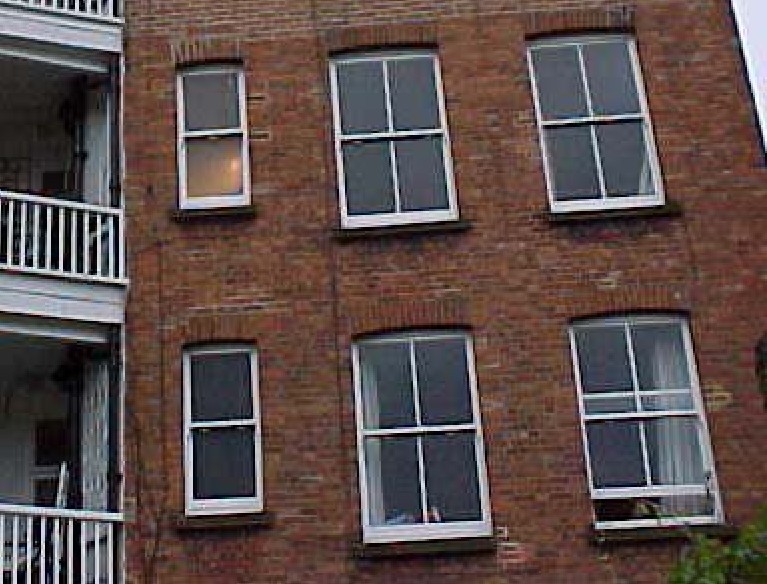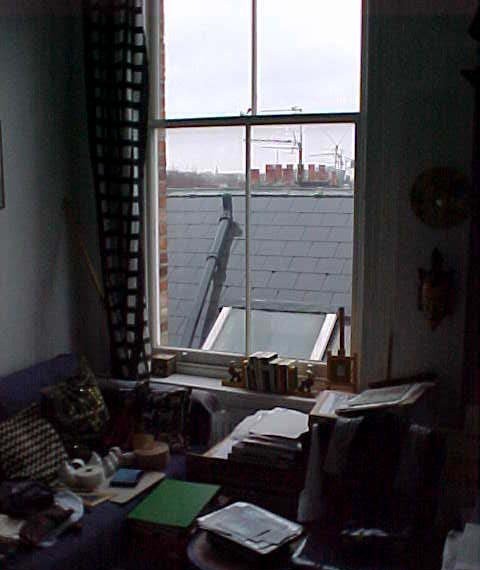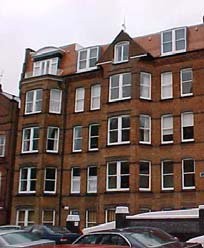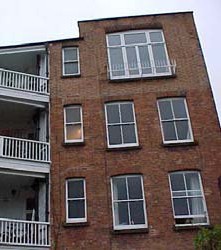



Original sash windows
Dwelling:
1910, 3 bedroomed mansion flat
Exterior
Broken sash cord
DESCRIPTION OF HAZARD
Background: This is a five storey late Edwardian mansion block which has balcony access at the
rear. The living room of this third floor flat, also located at the rear, still retains its two original
vertical sliding box sash windows. Both of these have low sills (under 700 mm high).
A) Living room windows:- In each window, the two large sliding sashes comprise a thin frame, each
carrying two large panes of single glazing. All the sash cords are threadbare, and in one window,
the cord holding one side of the lower opening light has snapped. This window can still be opened
and will remain open due to the one remaining counter weight and the friction resulting from the
consequent tilting of the frame. In summer, both windows are regularly left open as the living room
faces due south and otherwise gets over-heated.
LIST OF RELEVANT MATTERS
LIKELIHOOD & OUTCOMES
A
a
Door design defects
-
b
Disrepair to doors
-
c
Door closer defects
-
d
Door location
-
e
Window design defects
-
f
Disrepair to windows
3
g
Window location
-
h
Non-safety glass
-
I
Unprotected gaps
-
j
Low headroom to doors
-
k
Low beams and ceilings
-
# Secondary hazards
None
Key
3
2
1
-
Vulnerable age
Related hazards
Living room window
Plan through jamb
Multiple locations
Yes
No
Secondary hazards
Yes
No
Rear elevation
A
-
Seriously defective
Defective
Not satisfactory
Satisfactory/NA
HHSRS VERSION 2
COLLISION & ENTRAPMENT
Persons aged 5 years or under
Falls between levels
Front elevation
Average likelihood, outcomes and HHSRS score for collision and entrapment for persons
aged 5 years or under in pre 1920 flats, 1997-99.
Score
HEALTH AND SAFETY RATING SYSTEM SCORES
Pre 1920 purpose-built Flat
LIKELIHOOD
< 4200
Low
High
1 in
32
Average: 76
Example
32
2400 1300 750 420 240 130
75
42
24
13
7.5
4
2.5
1.5 >
Justification
OUTCOMES
Class I
Class II
Class III
Class IV
Justification
RATING
The threadbare condition of the sash cords, particularly those of the most frequently
opened lower frames, suggests that the remaining cords and particularly that on the
sash where there is already a broken cord, could break during the following 12 months.
As this is most likely to snap while the window is being opened or closed, the likelihood
of harm is increased.
%
Average: 0.0
0.0
< 0.05 0.15 0.3
0.7
1.5
3
7
15
26
38 >
Av: 0.0
0.2
< 0.05 0.15 0.3
0.7
1.5
3
7
15
26
38 >
Av: 2.8
21.5
< 0.05 0.15 0.3
0.7
1.5
3
7
15
26
38 >
Av: 97.2
78.3
43
0.0
0.2
21.5
78.3
< 0.05 0.15 0.3
0.7
1.5
3
7
15
26
38 >
The major proportion of collision and entrapment accidents involve trapping limbs or
fingers in doors and casement windows. The vertical motion of this sash window and
heavy weight due to the large panes of glass and the fact that the latter could shatter if
the frame slipped down without the retention of the counter weights, increase the
possibility of the health outcomes being more severe than average.
Example
A B C D E F
Average: 24
G H
I
J
232
Score
RATING SCORES AFTER IMPROVEMENT
IMPROVE
Justification
NEW RATING
Av: Nos
Likelihood to
1 in
56
Outcomes to
0.0
0.1
4.6 95.3 %
Replacing all the sash cords with new sash cord and adjusting and balancing the sash
weights would reduce the likelihood towards the average for this hazard. However,
other work is advisable to reduce the risk of falls between levels, such as safety
catches, guards, or raising the window sills, and perhaps the installation of safety glass.
Improved
A B C D E F G H
Av: 24
I
J